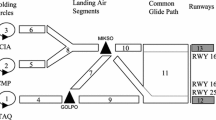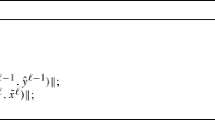Abstract
Disruptions in airline operations can result in infeasibilities in aircraft and passenger schedules. Airlines typically recover aircraft schedules and disruptions in passenger itineraries sequentially. However, passengers are severely affected by disruptions and recovery decisions. In this paper, we present a mathematical formulation for the integrated aircraft and passenger recovery problem that considers aircraft and passenger related costs simultaneously. Using the superimposition of aircraft and passenger itinerary networks, passengers are explicitly modeled in order to use realistic passenger related costs. In addition to the common routing recovery actions, we integrate several passenger recovery actions and cruise speed control in our solution approach. Cruise speed control is a very beneficial action for mitigating delays. On the other hand, it adds complexity to the problem due to the nonlinearity in fuel cost function. The problem is formulated as a mixed integer nonlinear programming (MINLP) model. We show that the problem can be reformulated as conic quadratic mixed integer programming (CQMIP) problem which can be solved with commercial optimization software such as IBM ILOG CPLEX. Our computational experiments have shown that we could handle several simultaneous disruptions optimally on a four-hub network of a major U.S. airline within less than a minute on the average. We conclude that proposed approach is able to find optimal tradeoff between operating and passenger-related costs in real time.





Similar content being viewed by others
References
AhmadBeygi, S., Cohn, A., Guan, Y., & Belobaba, P. (2008). Analysis of the potential for delay propagation in passenger airline networks. Journal of Air Transport Management, 14(5), 221–236.
Airbus (1998). Airbus flight operations support and line assistance, ‘getting to grips with the cost index’. Airbus Customer Services, Issue 2. http://www.iata.org/whatwedo/Documents/fuel/airbus_cost_index_material.pdf. Visited July 21, 2012.
Airbus (2004). Airbus flight operations support and line assistance, ‘getting to grips with fuel economy’. Airbus Customer Services, Issue 3. http://www.iata.org/whatwedo/Documents/fuel/airbus_fuel_economy_material.pdf. Visited July 21, 2012.
Barnhart, C., & Cohn, A. (2004). Airline schedule planning: accomplishments and opportunities. Manufacturing & Service Operations Management, 6(1), 3–22.
Barnhart, C., Fearing, D., & Vaze, V. (2012). Modeling passenger travel and delays in the national air transportation system. Working paper, Massachusetts Institute of Technology.
Ben-Tal, A., & Nemirovski, A. (2001). Lectures on modern convex optimization: analysis, algorithms, and engineering applications. Philadelphia: SIAM.
Boeing (2007). Fuel conservation strategies: cost index explained. AERO Quarterly Quarter, 2, 26–28.
Bratu, S., & Barnhart, C. (2006). Flight operations recovery: new approaches considering passenger recovery. Journal of Scheduling, 9, 279–298.
Clausen, J., Larsen, A., Larsen, J., & Rezanova, N. J. (2010). Disruption management in the airline industry—concepts, models and methods. Computers & Operations Research, 37, 809–821.
Cook, A., Tanner, G., Williams, V., & Meise, G. (2009). Dynamic cost indexing—managing airline delay costs. Journal of Air Transport Management, 15, 26–35.
Garrow, L. A. (2010). Discrete choice modelling and air travel demand: theory and applications. Aldershot: Ashgate Publishing.
Garrow, L. A., Jones, S. P., & Parker, R. A. (2010). How much airline customers are willing to pay: an analysis of price sensitivity in online distribution channels. Journal of Revenue and Pricing Management, 6(1), 1–20.
Gopalan, R., & Talluri, K. T. (1998). Mathematical models in airline schedule planning: a survey. Annals of Operations Research, 76(1), 155–185.
Graham, R. J., Garrow, L. A., & Leonard, J. D. (2010). Business travelers’ ticketing, refund, and exchange behavior. Journal of Air Transportation Management, 16(4), 196–201.
Jafari, N., & Zegordi, S. H. (2010). The airline perturbation problem: considering disrupted passengers. Transportation Planning and Technology, 33(2), 203–220.
Jarrah, A. I. Z., Yu, G., Krishnamurthy, N., & Rakshit, A. (1993). A decision support framework for airline flight cancellations and delays. Transportation Science, 27(3), 266–280.
Lan, S., Clarke, J.-P., & Barnhart, C. (2006). Planning for robust airline operations: optimizing aircraft routings and flight departure times to minimize passenger disruptions. Transportation Science, 40(1), 15–28.
Lovegren, J. A., & Hansman, R. J. (2011). Quantification of fuel burn reduction in cruise via speed and altitude optimization strategies. Tech. Rep. ICAT-2011-03, Massachusetts Institute of Technology, International Center for Air Transportation (ICAT).
Kohl, N., Larsen, A., Larsen, J., Ross, A., & Tiourine, S. (2007). Airline disruption management—perspectives, experiences and outlook. Journal of Air Transport Management, 13(3), 149–162.
Marla, L., Vaaben, B., & Barnhart, C. (2011). Integrated disruption management and flight planning to trade off delays and fuel burn. Tech. Rep., DTU Management, 2011.
Petersen, J. D., Sölveling, G., Clarke, J.-P., Johnson, E. L., & Shebalov, S. (2012). An optimization approach to airline integrated recovery. Transportation Science, 46(4), 482–500.
Rosenberger, J. M., Johnson, E. L., & Nemhauser, G. L. (2003). Rerouting aircraft for airline recovery. Transportation Science, 37(4), 408–421.
Stojkovic, G., Soumis, F., Desrosiers, J., & Solomon, M. M. (2002). An optimization model for a real-time flight scheduling problem. Transportation Research. Part A, Policy and Practice, 36(9), 779–788.
Thengvall, B. G., Bard, J. F., & Yu, G. (2000). Balancing user preferences for aircraft schedule recovery during irregular operations. IIE Transactions, 32, 181–193.
Author information
Authors and Affiliations
Corresponding author
Rights and permissions
About this article
Cite this article
Arıkan, U., Gürel, S. & Aktürk, M.S. Integrated aircraft and passenger recovery with cruise time controllability. Ann Oper Res 236, 295–317 (2016). https://doi.org/10.1007/s10479-013-1424-2
Published:
Issue Date:
DOI: https://doi.org/10.1007/s10479-013-1424-2




